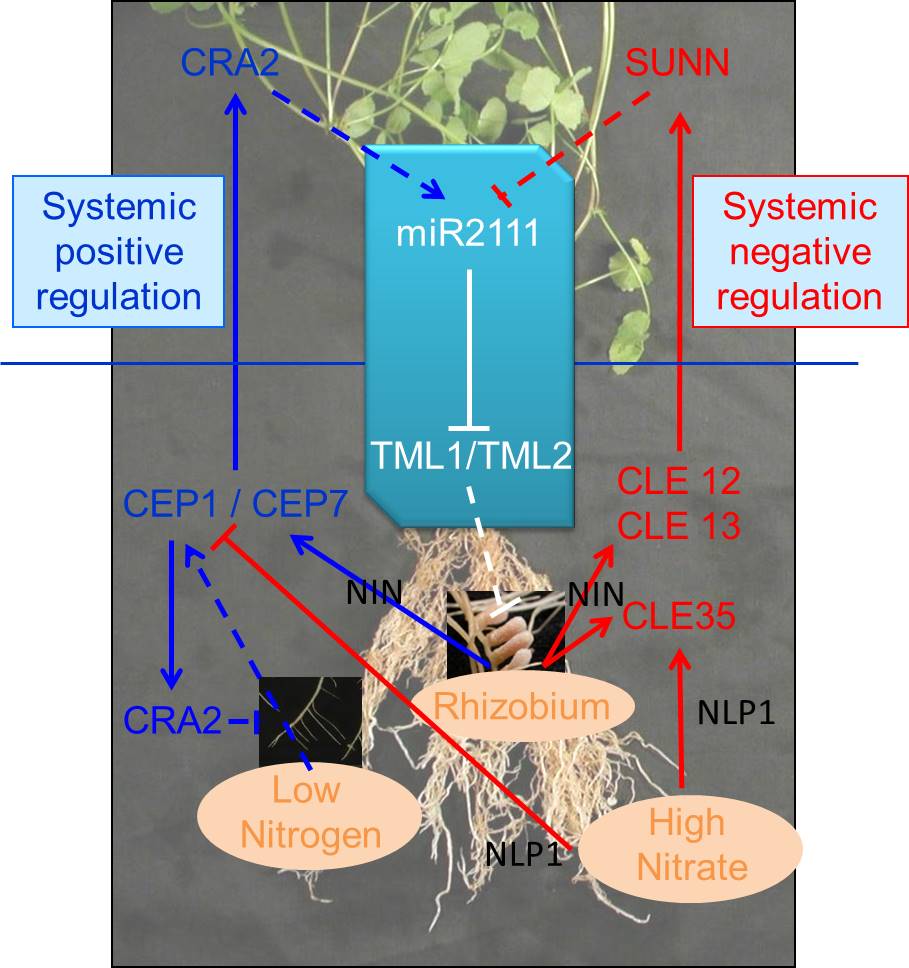Systemic regulation of nodulation and root development
Team SILEG / Florian Frugier
Forward genetic screens allowed us to identify mutants affected both in root and nodule development, referred to as compact root architecture (cra ; Laffont et al., 2010).
One of these mutants, cra2 , affects antagonistically nodule and lateral root development and is defective in a CLAVATA1-like LRR-RLK (Huault et al., 2014). Graft experiments showed that the regulation of symbiotic nodulation was determined by the activity of the receptor in shoots, implying a systemic regulation of root nodulation. The MtCRA2-dependent pathway is required for the action of C-terminally Encoded Peptides 1 (MtCEP1) signaling peptides, either to regulate positively nodulation and negatively lateral root formation (Mohd-Radzman et al., 2016). This CEP/CRA2 systemic positive regulation of nodulation acts independently from another systemic negative pathway previously identified, and named autoregulation of nodulation, relying on the Super Numeric Nodules" (SUNN) receptor and on CLAVATA3-like (CLE) signaling peptides (Laffont et al., 2019). A coordination exists between these two systemic pathways to regulate dynamically the number of nodules formed on the root system depending on environmental conditions, first through the regulation of a common effector module involving a microRNA, the miR2111, produced in shoots and acting in roots on TML (Too Much Love) 1 and TML2 targets regulating negatively nodulation (Gautrat et al., 2019; Gautrat et al., 2020); and second, by the coordinated production of specific CEP and CLE signaling peptides depending on environmental conditions, and notably of MtCEP7 and MtCLE13 in response to rhizobium or Nod factors through the cytokinin/CRE1 receptor pathway and the NIN transcription factor (Laffont et al., 2020). More recently, we showed that cytokinins and another microRNA, the miR399, participate in the systemic regulation of root system development, including nodulation, in nitrogen satiety conditions (Argiro et al., 2024).
More generally, these modules regulating nitrogen-fixing symbiotic nodulation integrates into systemic mechanisms controling plant nitrogen acquisition, as described in Gautrat et al. (2021). Accordingly, MtCLE35, one of the CLE signaling peptide regulating negatively nodule number and rhizobial infections through the SUNN-dependent systemic pathway and the miR2111/TML module, has an expression upregulated not only by rhizobium, but also by high nitrate conditions, depending on the MtNLP1 (NIN-Like Protein 1) transcription factor (Moreau et al., 2021). In addition, in response to nitrate, MtNLP1 not only activates directly the expression of MtCLE35 through the binding of Nitrate Response Elements (NREs) in its promoter, but also represses directly the expression of the CEP1 signaling peptide that promotes nodulation, through the binding of half NREs in its promoter (Luo et al., 2022).
Finally, we also showed that, beyond root system development and nodulation, the CEP/CRA2 pathway also promotes the root competence for symbiotic arbusculo-vesicular myccorhization under low nitrogen and low phophate conditions (Pedinotti & Tessendier de la Serve et al., 2024).

